NOT EVERYTHING IS GIVEN
Zişan, Felaket (Catastrophe), 1923. Reproduction of an original work of ink on paper.
Courtesy of the İz Öztat and Zilberman Gallery, Istanbul.
Exhibition
May 9, 2024–May 24, 2024
2024 Whitney Independent Study Program Curatorial Exhibition
ISP, 745 Washington Street (former studio of Roy Lichtenstein)
Noor Abed, Laakuluk Williamson Bathory, Niloufar Emamifa, Naomi Rincón Gallardo, Aziz Hazara, Joyce Joumaa, BAÇOY KOOP, Diyar Mayil, Shala Miller, İz Öztat, Taqralik Partridge, Kameelah Janan Rasheed, Cameron Rowlan, Ebun Sodipo, Oraib Toukan,
Charisse Pearlina Weston, Zişan
Whitney Independent Study Program Helena Rubinstein Curatorial Fellows:
Ella den Elzen, Gervais Marsh, Carlota Ortiz Monasterio, Alper Turan
The aspirations of language often leave words skirting around the edges of emotions, grasping at their depth. What fuels the demand to decipher as a measure of value or the foundation of understanding? This exhibition disturbs the expectations from artworks and artists to “demonstrate,” “elucidate,” or ‘’bear witness’’ to the fraught conditions of our world. Amid multiple ways of knowing and forms of communication, not everything has to be given or shared.
The artists gathered here circumvent and interrogate the expectations placed on them by overdetermined categories (race, sexuality, gender, ethnicity, geography), reorienting towards the self and those with shared experiences. In doing so, they complicate histories of past and present genocide, logics of anti-Blackness and settler colonialism, and gesture to concealed structures of control, including those imposed by the State, the law, and the archive. Through practices of withholding and self-articulation, they interrupt linear narratives using forms of coded communication, experimenting with strategies of obscurity and material form while affirming the poetics of mythmaking and fiction and underscoring the fragility of subjecthood.
As curators, we reckon with the urge to respond to the pervasive and gratuitous violence that is foundational to the world we live in and extends to the history of exhibition-making. Holding these tensions, we suspend the need to comprehend to consider alternative social and political modes.
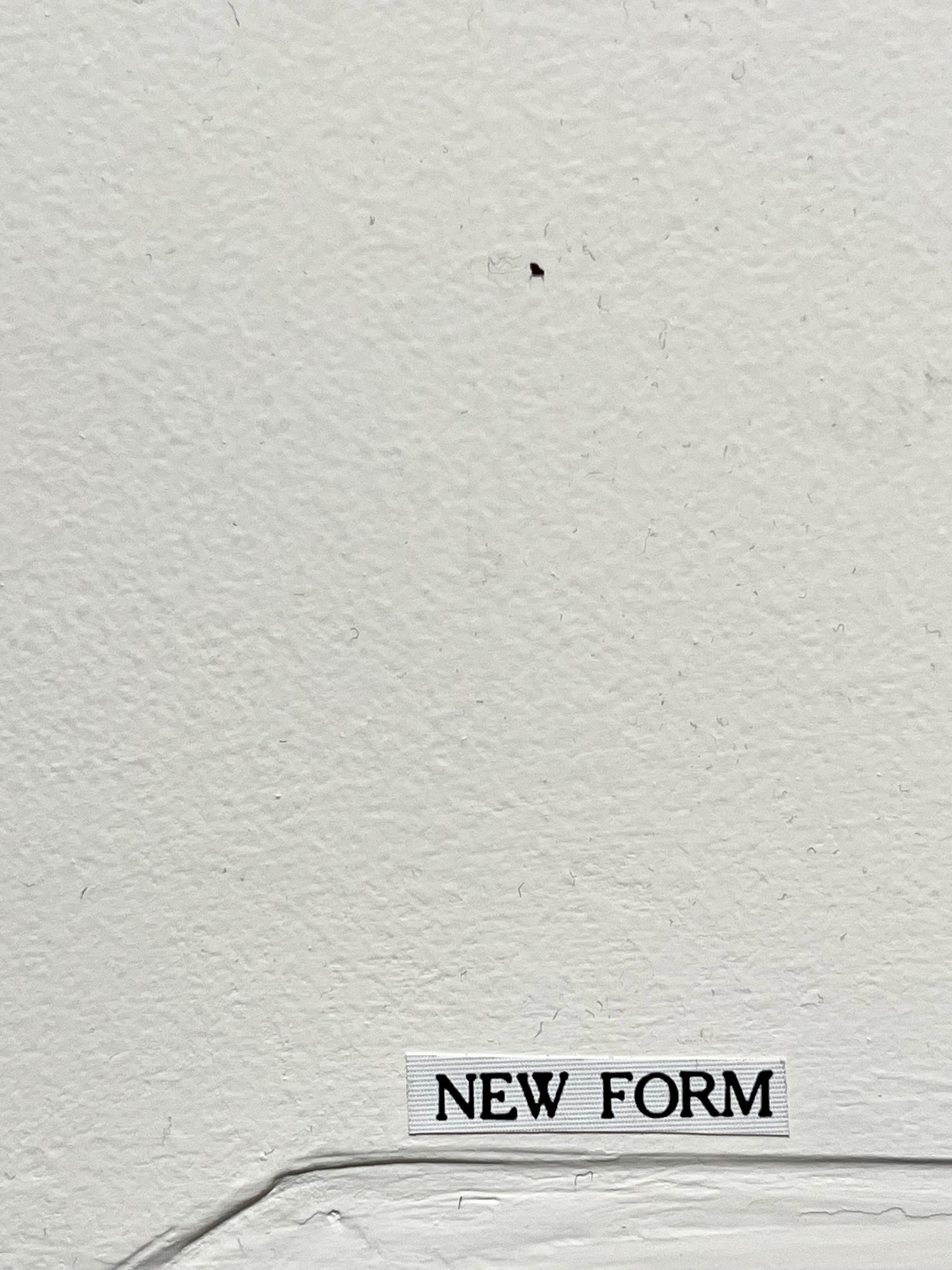
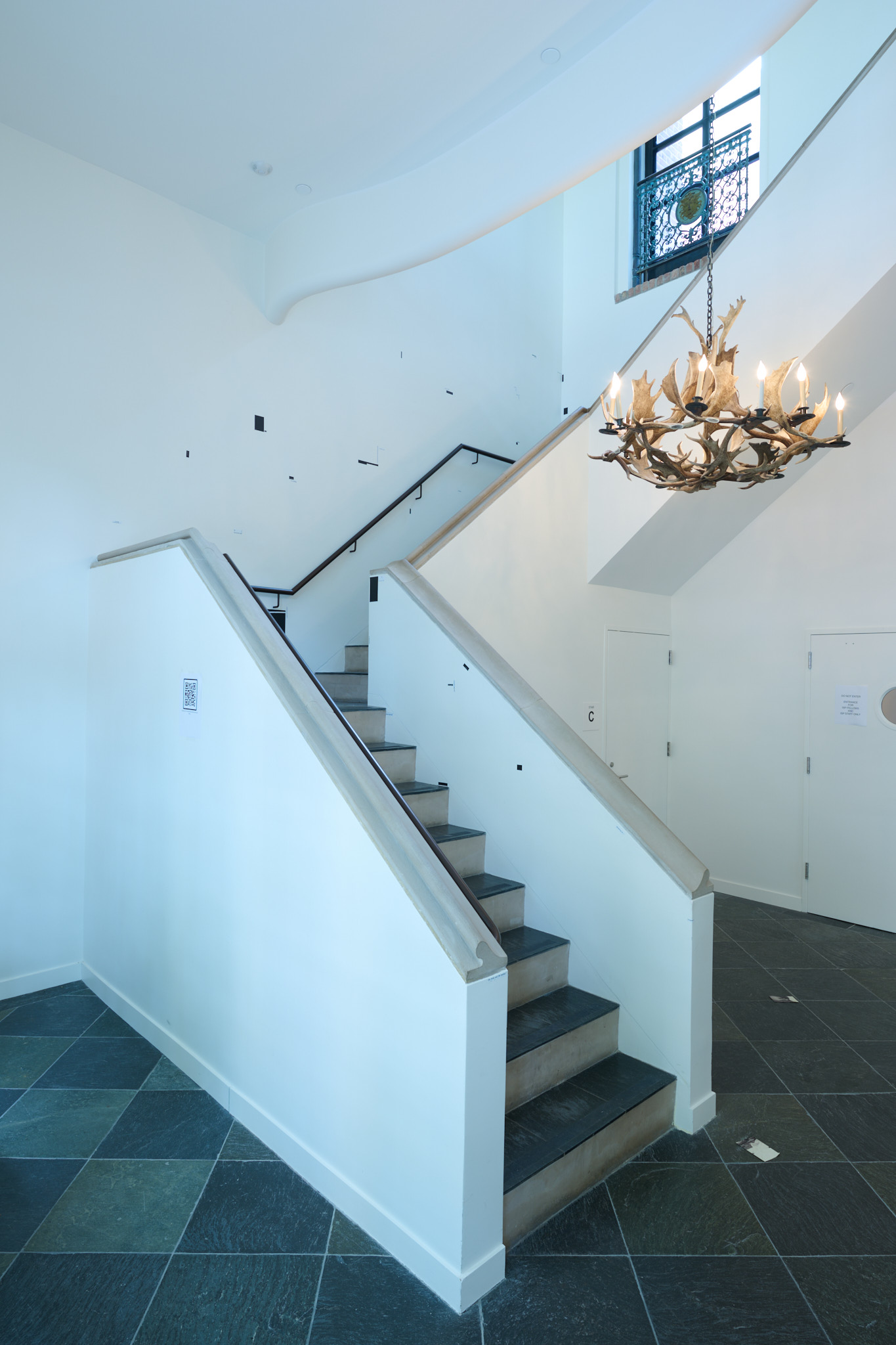
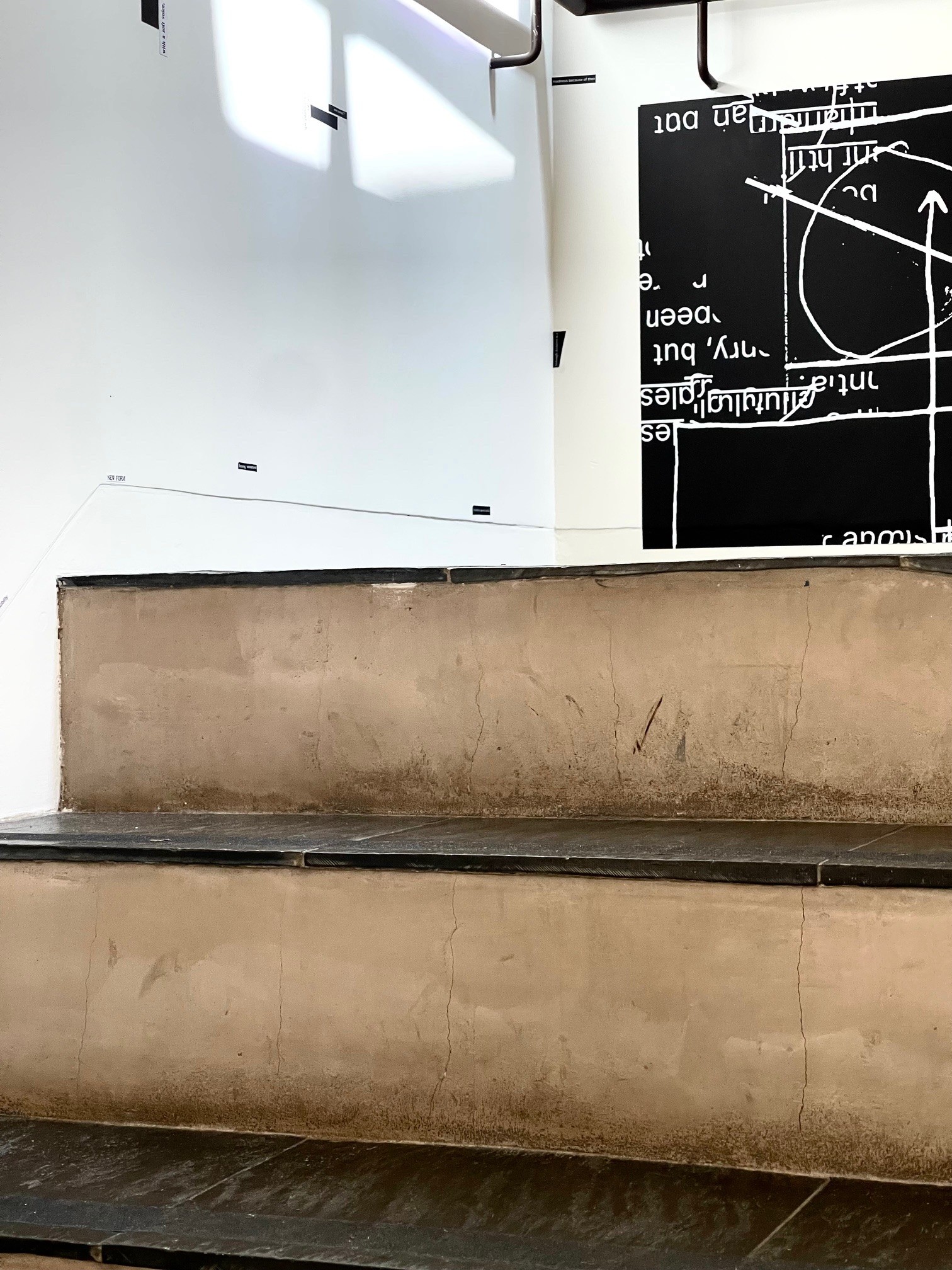


Installation view of Not Everything is Given: Whitney ISP 23/24 Curatorial Exhibition (Independent Study Program, New York, May 9-May 24, 2024). Kameelah Janan Rasheed,
,they feed on the altitude of our afterlife., 2024. Photograph by Filip Wolak
Vinyl
Courtesy of the artist and Nome Gallery, Berlin.
,they feed on the altitude of our afterlife. combines hand-drawn mathematical notation, a poem obscured using Photoshop’s content-aware function, and scans of Xeroxes. Arranged along the staircase, In combination with this larger vinyl work, small vinyl pieces of text have escaped the frame or spilled out of the confines of a sentence. This work considers the questions posed by Fred Moten in conversation with Renee Gladman’s work in the text One Long Black Sentence:
“Is there refuge in the sentence? Is there an underground railroad in the sentence?” --K.J.R



BAÇOY KOOP, Birding, 2016
Reproduction of mimeograph printed flyers
Courtesy of the artists
The work by BAÇOY-KOOP (Printing, Duplication and Distribution Cooperative) is named after the clandestine printing and distribution method originally used by Kurdish guerrillas, which involves the production of dissident content using non-electric mimeographs and the anonymous dissemination of flyers by scattering them from mountaintops down into villages. Created in 2016 amid heightened tensions from failed peace negotiations and increased state violence against Kurdish communities, Birding responds through coded visual and gestural language using symbols of Kurdish life and resistance.


Installation view of Not Everything is Given: Whitney ISP 23/24 Curatorial Exhibition (Independent Study Program, New York, May 9-May 24, 2024).
From left to right: Zişan, Felaket (Catastrophe), 1923; Oraib Toukain, Offing, 2021. Photograph by Filip Wolak
Oraib Toukain, Offing, 2021
Single-channel video, 28 mins and 15 secs
Courtesy of the artist
"Offing" (2021) emerges from the summer 2021 war on Gaza and a Zoom conversation between Berlin and Gaza with artist Salman Nawati, whose spoken words against Toukan's footage from outside Gaza narrate both the hardships and the mundane realities of daily life under the conditions of war. Exploring how to project images onto others’ accounts of suffering, pondering the space where speech and imagination meet, Offing is part of Toukan’s engagement with ‘cruel images’ that frame certain subjects within stifled narratives. Through close-ups, lush visuals, and manipulations of time such as reversing or changing the speed of footage, "Offing" attempts to rewrite horrific events.

Zişan, Felaket (Catastrophe), 1923
Reproduction of an original work of ink on paper
Courtesy of the İz Öztat and Zilberman Gallery, Istanbul
In her ongoing body of work, İz Öztat constructs the (auto)biography of Zişan (1894-1970), who appears to her as a historical figure, a ghost, and an alter ego. She adopts Zişan’s work to create a complex temporality that allows the suppressed past to intervene in the increasingly authoritarian present. Fleeing Istanbul with her father in 1915 to escape the Armenian Genocide and meandering through the canon of avant-garde art without being noticed, Zişan disseminated her work anonymously. Here, she attempts to represent the unrepresentable, unrecognized genocidal violence through geometrical abstraction and text that reads "Catastrophe."

Noor Abed, our songs were ready for all wars to come, 2021
Single-channel video, 19 mins 50 secs
Courtesy of the artist
our songs were ready for all wars to come stems from Abed's interest in folklore and social choreography and the way political ideologies are enacted through everyday movements. With a tone between magical realism and archival footage, the film, set in dialogue with a specific location in Palestine and shot together with family members and friends, features choreographed scenes inspired by Palestinian folktales associated with water wells, which are central to communal rituals of disappearance, mourning, and death. Through a narrative delivered entirely in song, with lyrics colleaged from these folktales, Abed explores how myths and movements can serve as tools to challenge dominant discourses, reclaim the narratives, and reshape the realities.
Naomi Rincón Gallardo, Resiliencia Tlacuache (Opossum Resilience), 2019
Single-channel HD video, 16 mins 01 secs
Courtesy of the artist and Parallel Oaxaca, Oaxaca
Set in the hills of Oaxaca, Mexico, and inspired by encounters with local land defenders, this fabulation by Naomi Rincón Gallardo traces an unlikely relation between four figures: a Hill, an Agave, an Opossum, and the Mixtec deity Lady Reed. With her characteristic use of humor, speculative fiction, vernacular crafts, and theatrical techniques, the artist deliberately “bastardizes” Mesoamerican myths with elements of contemporary popular culture, disturbing the demands placed on Indigenous knowledge and challenging the discourses and policies that relegate Indigenous cultures in Mexico to the ancient past and fail to recognize these groups’ rights.


Installation view of Not Everything is Given: Whitney ISP 23/24 Curatorial Exhibition (Independent Study Program, New York, May 9-May 24, 2024).
From left to right: Diyar Mayil, Mop, 2022; Joyce Joumaa, Hallab Bldg, 2024; Joyce Joumaa, Mafra’ Baladiye, 2024. Photograph by Filip Wolak
From left to right: Diyar Mayil, Mop, 2022; Joyce Joumaa, Hallab Bldg, 2024; Joyce Joumaa, Mafra’ Baladiye, 2024. Photograph by Filip Wolak
Joyce Joumaa, Hallab Bldg & Mafra' Baladiye, 2024
Inkjet on archival vellum paper, breaker box, stainless steel, computerized timer, light
Courtesy of Musée d’art contemporain de Montréal and Galerie Eli Kerr, Montreal
Hallab Bldg and Mafra Baladiye speak to the contemporary energy crisis in Lebanon, a result of state economic mismanagement. The work consists of a breaker box that has been repurposed as a lightbox for a backlit photograph, an image of the interior of a Tripoli apartment. Set on a timer, the work becomes illuminated at the same time that the residents of this apartment have electricity. Most people experience blackouts throughout the day, and neighbors have created schedules to determine when to share power.


Installation view of Not Everything is Given: Whitney ISP 23/24 Curatorial Exhibition (Independent Study Program, New York, May 9-May 24, 2024). Diyar Mayil, Mop, 2022. and Sitting Through, 2019. Photograph by Filip Wolak
Diyar Mayil
Mop, 2022
Glass, metal
Courtesy of the artist
Sitting Through, 2019
Silicone, ceramic, wood, salt
Courtesy of the artist
Working through themes of alienation and foreignness, Mayil’s sculptures of domestic objects contend with the positionality of being both host and a guest within nations. Quotidian household furnishings, such as a table, and mop, are made materially unfamiliar. Alluding to conceptualizations of visibility and invisibility, comfort and discomfort, Mayil’s works contemplate the contradictions of what it means to be simultaneously stateless and at home, and how the body holds these tensions.
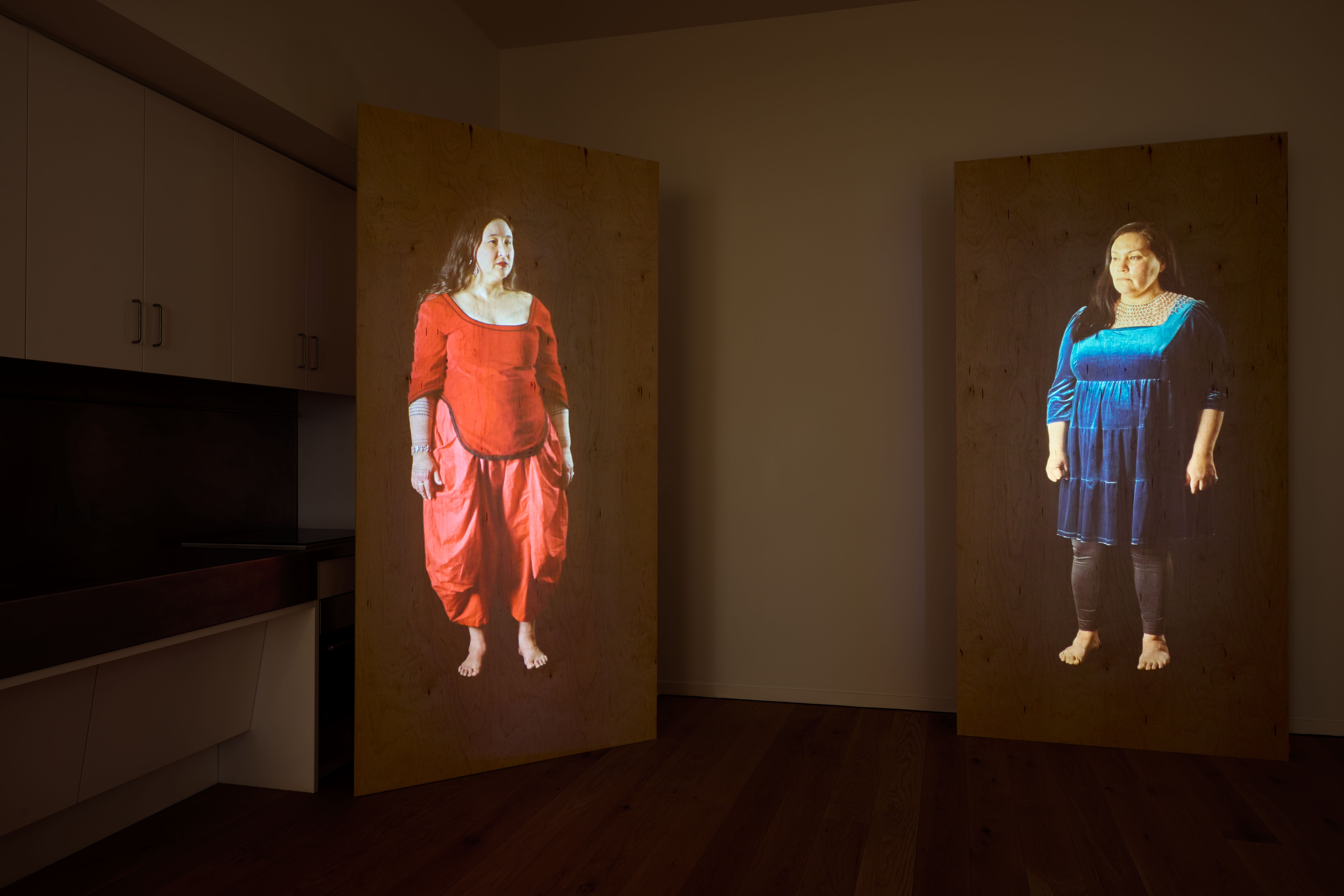
Installation view of Not Everything is Given: Whitney ISP 23/24 Curatorial Exhibition (Independent Study Program, New York, May 9-May 24, 2024). Taqralik Partridge and Laakkuluk Williamson Bathory, Inissaliortut: Making Room, 2022.
Photograph by Filip Wolak
Photograph by Filip Wolak
Taqralik Partridge and Laakkuluk Williamson Bathory, Inissaliortut: Making Room, 2022
Two-channel video, 19 mins; plywood panels
Commissioned by the CCA for the exhibition ᐊᖏᕐᕋᒧᑦ / Ruovttu Guvlui / Vers chez soi / Towards Home
© Laakkuluk Williamson Bathory
In this video, Taqralik Partridge and Laakkuluk Williamson Bathory directly address one another, as friends, co-conspirators, and mothers—acknowledging and affirming each others’ knowledge as Inuit women. Through their dialogue, they point to how the colonization of the Arctic has been enacted through government policy while attending to the everyday experiences and familiar places inhabited by Inuit communities. Larger than human scale, they are in conversation first and foremost with one another.
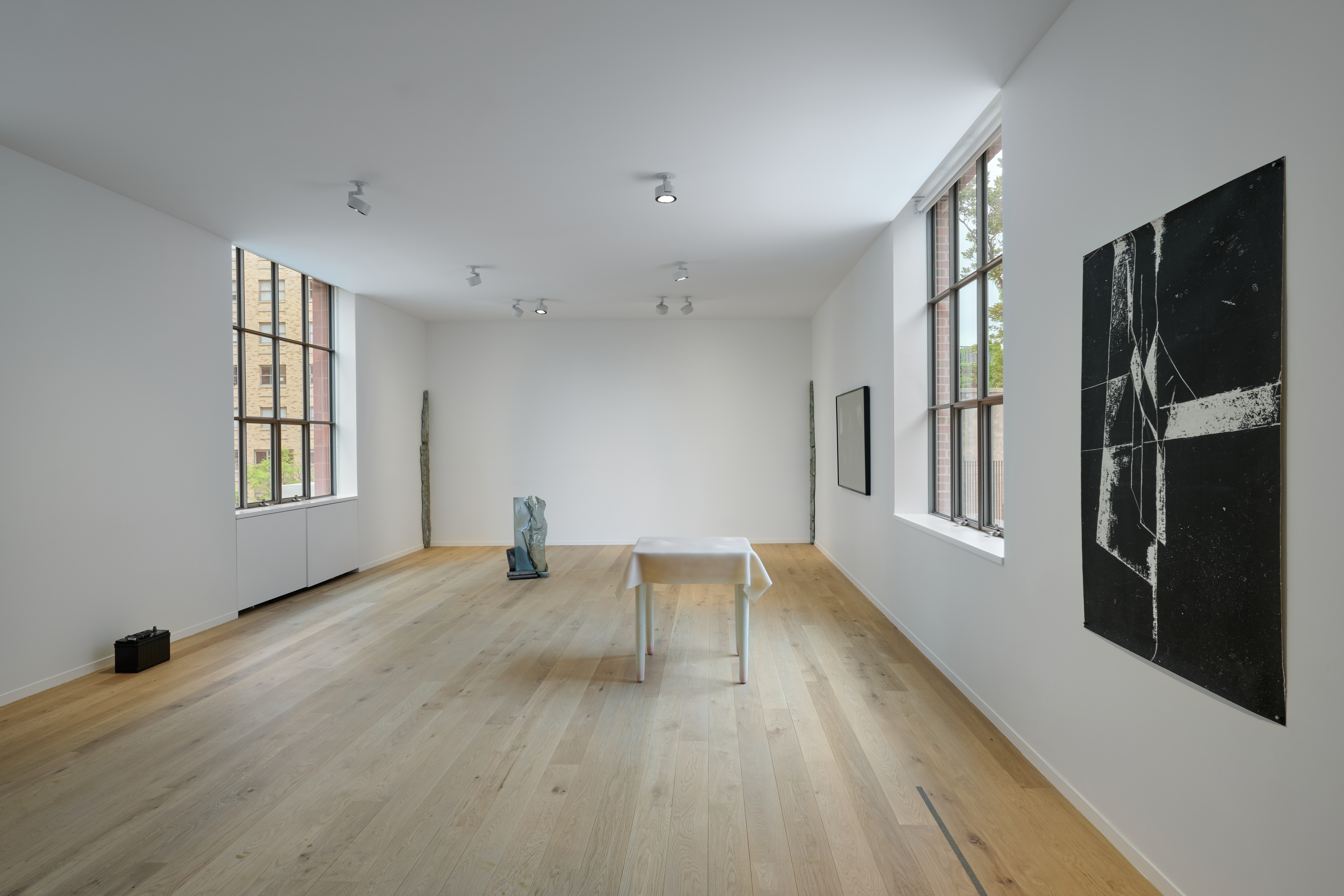
Installation view of Not Everything is Given: Whitney ISP 23/24 Curatorial Exhibition (Independent Study Program, New York, May 9-May 24, 2024). From left to right: Cameron Rowland, 0D20612, 2014; Niloufar Emamifar, Three Inches And A Half, 2018; Charisse Pearlina Weston, diaphanous envelop of the object side, 2024; Diyar Mayil, Sitting Through, 2019; Niloufar Emamifar, Three Inches And A Half, 2018; Shala Miller, The Makings of a Supervillain, 2023; Charisse Pearlina Weston, that old saying is true: you’ve got to weep what you sow, 2017. Photograph by Filip Wolak
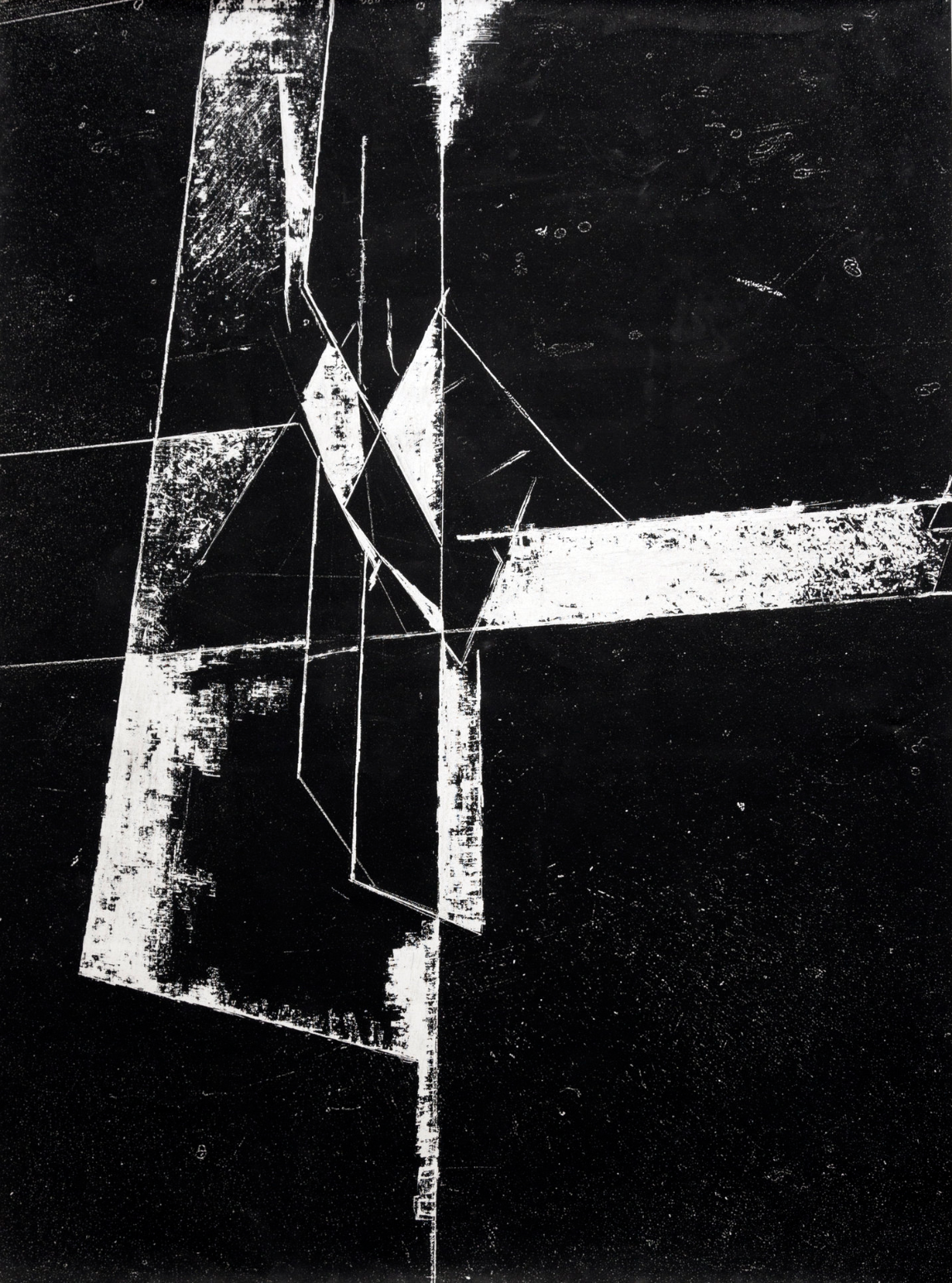
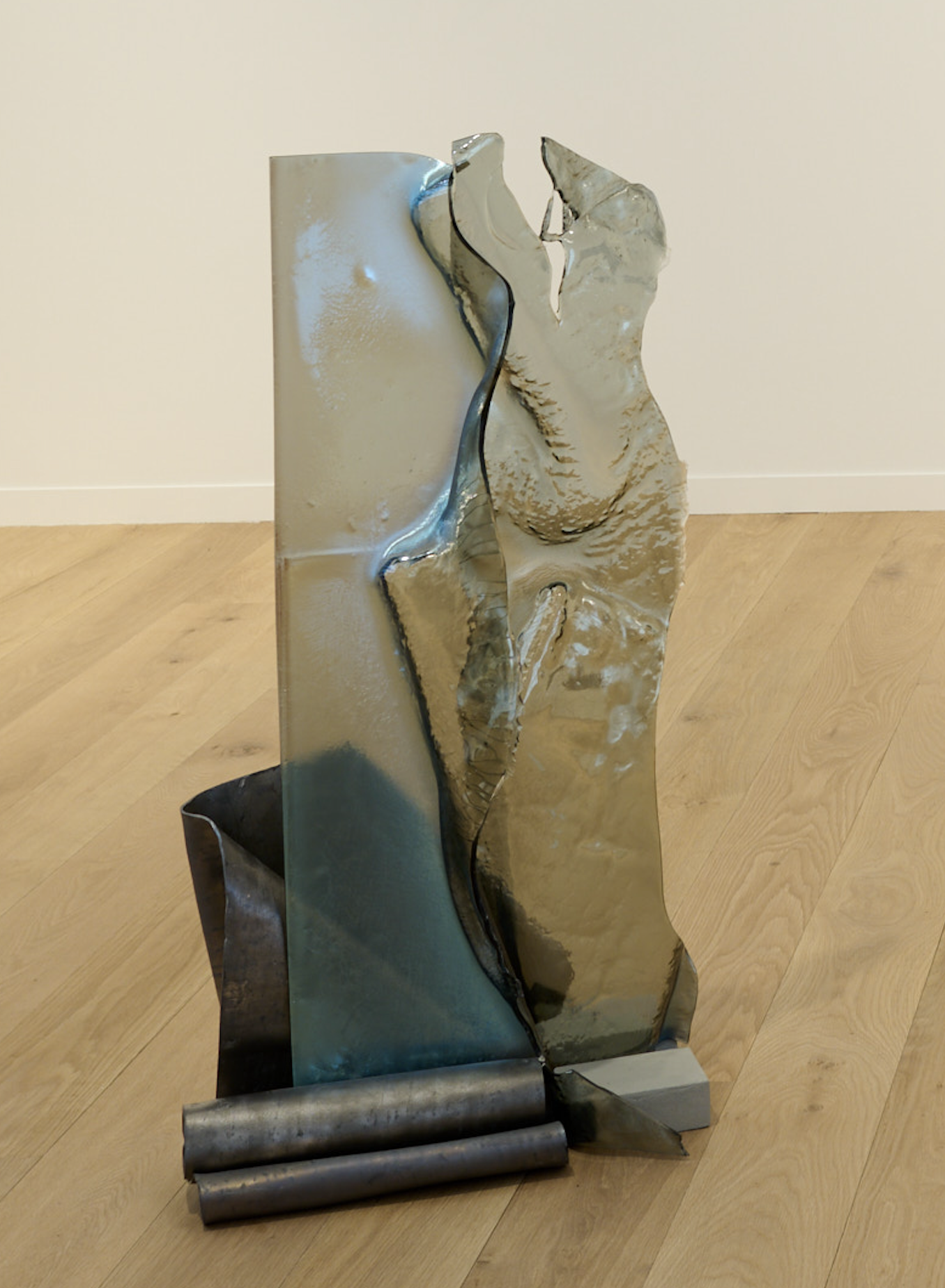
Charisse Pearlina Weston
that old saying is true: you’ve got to weep what you sow, 2017
Inkjet print on Hahnemuhle canvas etched with replacement frame glass from collapse, glass, canvas, glass shards
Courtesy of the artist; PATRON Gallery, Chicago; and Jack Shainman Gallery, New York
diaphanous envelop of the object side, 2024
Slumped and etched mirropane, lead, and concrete
Courtesy of the artist; PATRON Gallery, Chicago; and Jack Shainman Gallery
Charisse Pearlina Weston engages practices of concealment, repetition, and enfoldment to consider the complexities and generative potential of Black interior life as sites of resistance. Diaphonous envelop of the object side draws on the material dimensions of the mirropane, thinking critically about structures of surveillance and opacity, with Weston’s poetic gestures interwoven throughout the piece.

Installation view of Not Everything is Given: Whitney ISP 23/24 Curatorial Exhibition (Independent Study Program, New York, May 9-May 24, 2024).
From left to right: Charisse Pearlina Weston, diaphanous envelop of the object side, 2024; Niloufar Emamifar, Three Inches And A Half, 2018; Shala Miller, The Makings of a Supervillain, 2023; Diyar Mayil, Sitting Through, 2019; Charisse Pearlina Weston, that old saying is true: you’ve got to weep what you sow, 2017. Photograph by Filip Wolak
From left to right: Charisse Pearlina Weston, diaphanous envelop of the object side, 2024; Niloufar Emamifar, Three Inches And A Half, 2018; Shala Miller, The Makings of a Supervillain, 2023; Diyar Mayil, Sitting Through, 2019; Charisse Pearlina Weston, that old saying is true: you’ve got to weep what you sow, 2017. Photograph by Filip Wolak

Shala Miller, The Makings of a Supervillain, 2023
Archival pigment print on William Turner paper, hand engraving on plexiglass
Courtesy of the artist
Shala Miller’s practice meditates on the conjunction of desire, mourning, pain, and pleasure, and under the moniker of Freddie June, explores the voice as material. The Makings of a Supervillain leans into fiction, constructing narratives of the character Obsidian to consider the convergence of rage, resistance, and desire within Black femme life.

Installation view of Not Everything is Given: Whitney ISP 23/24 Curatorial Exhibition (Independent Study Program, New York, May 9-May 24, 2024).
From left to right: Niloufar Emamifar, Three Inches And A Half, 2018; Charisse Pearlina Weston, diaphanous envelop of the object side, 2024; Niloufar Emamifar, Three Inches And A Half, 2018. Photograph by Filip Wolak
From left to right: Niloufar Emamifar, Three Inches And A Half, 2018; Charisse Pearlina Weston, diaphanous envelop of the object side, 2024; Niloufar Emamifar, Three Inches And A Half, 2018. Photograph by Filip Wolak
Niloufar Emamifar
Niloufar Emamifar, Three Inches And A Half, 2018
Pigmented hard plastic, paint, clay, dirt
Collection of Gabriel Catone, New York
This work consists of two parts, cast in situ between a Palestinian-owned mechanic shop and a former mechanic shop (also previously owned by the family) in Los Angeles' Koreatown. Capturing the vertical space between the two properties, the work delineates parcels of property subject to agreements between private and public sectors. In urban legal terminology, this agreement demarcates these spaces as abstracted lines on zoning maps, devoid of specific dimensions or tangible attributes, and thus, value. In drawing our attention to these overlooked sites, this work troubles notion of property ownership in the United States and the “unsubstantiality” of these spaces, which, in their very existence, reinforce conceptualizations of value, language, and the law.
Pigmented hard plastic, paint, clay, dirt
Collection of Gabriel Catone, New York
This work consists of two parts, cast in situ between a Palestinian-owned mechanic shop and a former mechanic shop (also previously owned by the family) in Los Angeles' Koreatown. Capturing the vertical space between the two properties, the work delineates parcels of property subject to agreements between private and public sectors. In urban legal terminology, this agreement demarcates these spaces as abstracted lines on zoning maps, devoid of specific dimensions or tangible attributes, and thus, value. In drawing our attention to these overlooked sites, this work troubles notion of property ownership in the United States and the “unsubstantiality” of these spaces, which, in their very existence, reinforce conceptualizations of value, language, and the law.

Three Inches And A Ha
Cameron Rowland, 0D20706, 2014
Lojack transmitter, car battery
Courtesy of the artist and Maxwell Graham Gallery, New York.
LoJack is only available aftermarket. When installed, the transmitter serial number and the VIN are registered in a database at the National Crime Information Center, directly linked to enforcement. LoJack receivers in police cars search the serial number of the transmitter based on the VIN of the missing vehicle. This is an unused, unregistered transmitter, powered, which operates for 200 milliseconds every 10 seconds at 173.075 MHz. The frequency 173.075 MHz is available for stolen vehicle recovery systems on a shared basis with the Federal Government.
- C.R.

Installation view of Not Everything is Given: Whitney ISP 23/24 Curatorial Exhibition (Independent Study Program, New York, May 9-May 24, 2024).
From left to right: Charisse Pearlina Weston, that old saying is true: you’ve got to weep what you sow, 2017;
Ebun Sopido, Prosthesis for freedom - Mary Jones’ piece of cow leather pierced and opened like a woman’s womb’, 2022;
Aziz Hazara, Takbir, 2021. Photograph by Filip Wolak
From left to right: Charisse Pearlina Weston, that old saying is true: you’ve got to weep what you sow, 2017;
Ebun Sopido, Prosthesis for freedom - Mary Jones’ piece of cow leather pierced and opened like a woman’s womb’, 2022;
Aziz Hazara, Takbir, 2021. Photograph by Filip Wolak
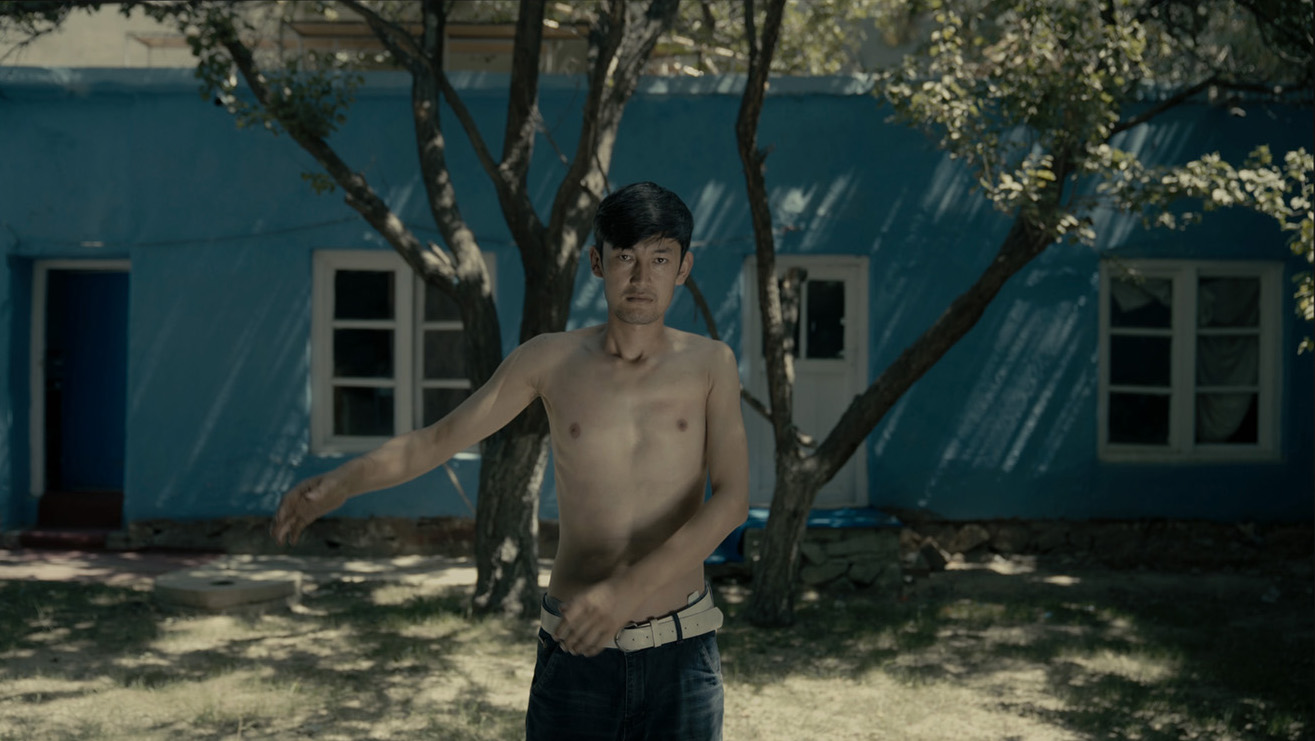
Aziz Hazara, Takbir, 2021
Single-channel video, 5 mins
Courtesy of the artist and Experimenter, Kolkata
Takbir (2021) presents a scene where a young man beats his chest while staring intensely into the camera. This act echoes the collective mourning rituals during Ashura, symbolizing resistance against injustice. Hazara uses this solitary act to explore how individual acts of mourning can challenge collective historical narratives and how sound contours subjectivity. The repetitive thud of flesh highlights the body's mortality, vulnerability, and agency, underscoring the physical effects of enduring injustice while questioning how mourning sounds in the absence of a shared language for grief.


Ebun Sopido, Prosthesis for freedom - Mary Jones' piece of cow leather pierced and opened like a woman's womb', 2022
Piece of cow leather pierced and opened like a woman's womb
Courtesy of the artist
Ebun Sodipo makes work for black trans people of the future, guided by black feminist study, with a methodology of collage and fabulation. Prosthesis for freedom-Mary Jones is a prosthetic vulva that gestures to the strategies of living employed by Mary Jones, a transgender woman who was a U.S. soldier and sex worker in the 19th century.
NOT EVERTYHING IS GIVEN
As we negotiate structures of comprehension and the expectations placed on artists and curators to make meaning through our practices, these essays are opportunities for reflection. Leaning into the questions that shape our curatorial approach, we think with the artists whose work is critical in shaping
Not Everything Is Given.
Joyce Joumaa’s two breaker boxes are repurposed as lightboxes for photographs taken at two homes in Lebanon where power cuts left the country blacked out through most of the day. Timed to the power schedules, the photos of two interior spaces light up or fade out with the electricity supply. When the power is cut, the images are barely perceptible, yet never truly gone—always there and palpable, showing themselves only when they can. The work does not shut down the electricity of the whole building to simulate Lebanon's life conditions. Instead, it generates a fleeting, illusory moment for compassion, acknowledging art’s limitation in fully communicating others' experiences. Compassion, as Laurent Berlant sketched out, often rooted in privilege, inherently falls short as it transforms the moral imperative to alleviate others' distress into a performative act that distances the spectator from the sustained commitment required to effect real change, reinforcing the very hierarchies it seeks to dismantle.
Not Everything is Given is an exhibition on withholding. It does not mean refusing to participate but participating on its own terms. It’s about withholding digestible documentation or cathartic narration of one’s struggle. Coming from different localities and experiences, the artists disturb expectations and eschew satisfaction for the audience. The works in the exhibition preserve the violence within themselves, bringing it to the surface without fully forming it, recognizing the flattening effect of communicating and experiencing other people’s suffering. We are merely brushing the surface, being momentarily touched by an image, then moving on to the next. Theresa Hak Kyung Cha, a ghost of the exhibition, writes on the tension between the urge to articulate and to withhold: “Inside is the pain of speech the pain to say. Larger still. Greater than is the pain not to say.” This tension is heightened by the knowledge that “to the others, these accounts are about (one more) distant land, like (any other) distant land, without any discernible features in the narrative, (all the same) distant like any other.” How can we communicate with the distant land without necessitating comprehension or apprehension of the foreign?
Conceived amid the relentless and audacious, live-streamed genocide in Palestine, we are confronted with "cruel images" that ‘‘selectively mute: it’s not that one refuses or chooses not to speak, it’s that one is left “literally unable to speak” about what is being seen.’’ These images do more than document—they participate in the violence, muting and weaponizing two-dimensional planes, effectively flattening political reimagination, and transforming viewers into complicit observers. The guilt of witnessing, of being drawn into the spectacle without truly comprehending or acting, and the shame of believing in art permeate the exhibition. Oraib Toukan's film Offing explores how to project images on other people’s suffering, pondering the space where speech and imagination meet. Emerging from the summer 2021 war on Gaza and an online conversation with artist Salman Nawati, whose spoken words from Gaza against Toukan's footage from outside Gaza. What we hear is the narration of the hardships and mundane realities of daily life under the conditions of war. What we see are close-ups, lush visuals, and manipulations of time, such as reversing or changing the speed of footage. Offing attempts to hear and relate to parallel stories behind the frame of war. Meaning the more distant part of the sea in view, offing suggests the limitations of perspective and the challenge of truly comprehending the experience of another, the one in the offing.
Kameelah Janan Rasheed’s site-specific installation, ,they feed on the altitude of our afterlife. studies the illusion of comprehensiveness that text, much like images, often projects. By employing a poem obscured, scattered, and arranged along a staircase, Rasheed disrupts expectations of legibility, clarity, and understanding. She challenges the notion that reading and seeing equate to understanding, emphasizing instead profound unknowability. Rasheed's installation underscores how meaning is always deferred, never fully graspable, and continuously shaped by what is absent or obscured. The scattered vinyl pieces of text, such as ‘A thing that seems to be ___ an output,’ ‘the ‘outside’ to that which,’ ‘Translator’s note,’ and ‘When it arrived, Your sentence is sweating,’ alongside black geometrical shapes reminiscent of censored images, serve as a metaphor for the elusive nature of meaning. They compel us to confront the gaps and silences that structure our perceptions and narratives. The unknowable, unseeable, and unreadable elements evoke the face of the Other, the ultimate image of ethical responsibility, which, as Derrida suggests, is not in front of us or even within our field of vision but is a ‘trace that dislocates the simplicity of (...) here-and-now present.’
A black square in the center of a paper accompanied by text in Ottoman is a work by Zişan (1894-1970). Fleeing Istanbul in 1915 to escape the Armenian Genocide, Zişan navigated the avant-garde art world unnoticed, disseminating her work anonymously. This piece Felaket, dated 1923—the year the denialist Turkish Republic was founded on the backdrop of the genocide—attempts to represent the unrepresentable and unrecognized genocidal violence through geometrical abstraction. The text reads "Catastrophe," a term connecting us to the Nakba, reflecting a shared history of legitimized violence and systematic denial. In her ongoing body of work, İz Öztat fabricates the (auto)biography of Zişan (1894-1970), who appears to her as a historical figure, a ghost, and an alter ego. She adopts Zişan’s work to create a complex temporality that allows the suppressed past to intervene in the increasingly authoritarian present. No Turkish government has admitted that what happened to the Armenians was a crime, let alone a genocide. It is illegal to define the "Armenian issue" as genocide. As an artist from Turkey, İz Öztat fabricates the life and work of Zişan, she is mutilating herself to pay her debt, the debt of surviving, the debt of not being imprisoned, not being massacred, the debt of being an artist and making art.
The two video works delve deeply into the embodied and unspoken responses to collective violence, examining how rituals and movements articulate resistance and grief. Noor Abed’s our songs were ready for all wars to come stems from Abed's interest in folklore and social choreography and the way political ideologies are enacted through everyday movements. With a tone of magical realism and archival footage, the work features choreographed scenes and a song inspired by Palestinian folktales and communal rituals of mourning and death. Abed explores how myths and movements can serve as tools to challenge dominant discourses, reclaim narratives, and reshape realities. Aziz Hazara’s Takbir presents a scene where a young man from Afghanistan beats his chest while staring intensely into the camera. This act echoes the collective mourning rituals during Ashura, symbolizing resistance against injustice. Hazara uses this individualized act to explore how personal expression of mourning can sound in the absence of a shared language for grief.
The coded, gestural language of mourning and resistance is evident in the work of BAÇOY KOOP (Printing, Duplication, and Distribution Cooperative). Their piece Birding is named after the clandestine printing and distribution method originally used by leftist organizations to duplicate and disseminate dissident content. Created in 2016 amid heightened tensions from failed peace negotiations and increased state violence against Kurdish communities, Birding refers to the action of throwing pamphlets into a crowd to disseminate information while blending in. This work brings the public act of dissemination into an interior space, reflecting a distrust of the public sphere. Formally, the work stands in stark contrast to the canonical paper stacks of Felix Gonzalez-Torres, which invite the audience to participate and take a piece. Instead, the papers scattered randomly on the floor of Birding disrupt the audience’s usual movement and expectation. Is it meant to be given, or is it to be shared?
There is another piece in the exhibition that is not on view, by Felix Gonzalez-Torres, an artist who shapes the exhibition without being physically present in it. Untitled (for Parkett) is a billboard piece depicting a cut-up section of sand with multiple, zigzagging footprints that appear to belong to different people. Originally intended for outdoor, public installation, it has been relocated to an indoor wall. This transition from public to private space underscores a distrust in the public realm. The supposedly safe distance between the audience and the artists/artworks has vanished, as the public space is under threat, if not entirely destroyed. Now, we are unsure whether we can take a paper from a stack or merely observe an image of sand with anonymous footprints within a secluded art space, monitored by security. Still, the image shows a stretch of land marked by footprints, a space that is unsettled, unowned, yet co-traversed and co-passed by many.
Niloufar Emamifar’s Three Inches and A Half casts, taken from the narrow space between two buildings in Los Angeles, highlight the materiality and contested nature of unowned land. Despite being deemed "value-less" in legal terms as mere abstracted lines on zoning maps, these spaces hold significance. Emamifar, in her quest to obtain permission from the owners of the properties to cast the intermittent spaces adjacent to their properties, found that only two Palestinian businesses allowed her access. This underscores how, in the context of Palestinian-owned properties, these seemingly insubstantial spaces are imbued with profound meaning. As citizens of a contested and stolen land, Palestinian owners uniquely understand and believe in the materiality of these non-owned spaces, revealing the deep, inherent value that transcends legal definitions and challenges conventional notions of property ownership.
Alper Turan
Notes:
1-Lauren Berlant, "Introduction Compassion (and withholding)." Compassion. Routledge, 2014. 1-13.
2-Theresa Hak Kyung Cha, Dictee, University of California Press, 2009, p. 3
3-ibid p.56
4-Oraib Toukan, "Cruel Images." e-flux Journal, no. 96, January 2019
5-Jacques Derrida, Adieu to Emmanuel Levinas, Stanford University Press, 1999, page 91.
